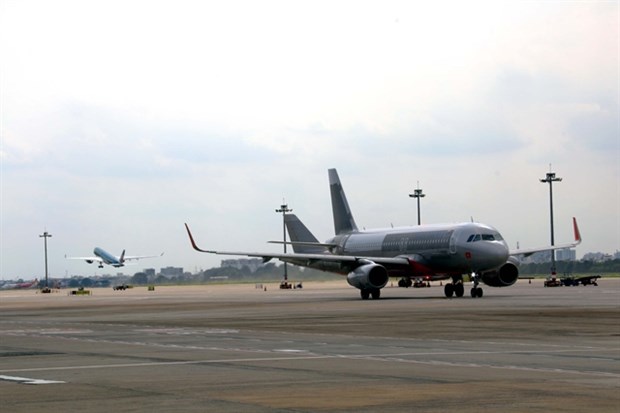Vietnam to have 30 airports by 2030
Vietnam is set to have 30 airports by 2030, including 14 serving international flights and 16 serving domestic flights.

An airplane lands in Tan Son Nhat International Airport in HCM City. (Photo: VNA)
The investment is estimated at about 420 trillion VND (18 billion USD), mobilised from the State budget, non-budget capital and other legal capital sources.
This information was released after Deputy Prime Minister Tran Hong Ha on June 7 signed Decision No 648/QD-TTg on the national airport system planning in the 2021-2030 period with a vision until 2050.
The 14 international airports are Van Don, Cat Bi, Noi Bai, Tho Xuan, Vinh, Phu Bai, Da Nang, Chu Lai, Cam Ranh, Lien Khuong, Long Thanh, Tan Son Nhat, Can Tho and Phu Quoc.
The 16 airports serving only domestic flights are Lai Chau, Dien Bien, Sa Pa, Na San, Dong Hoi, Quang Tri, Phu Cat, Tuy Hoa, Pleiku, Buon Ma Thuot, Phan Thiet, Rach Gia, Ca Mau, Con Dao, Bien Hoa and Thanh Son.
By 2050, the country will have 14 international airports and 19 domestic ones. The international airports include Van Don, Hai Phong, Noi Bai, Tho Xuan, Vinh, Phu Bai, Da Nang, Chu Lai, Cam Ranh, Lien Khuong, Long Thanh, Tan Son Nhat, Can Tho and Phu Quoc.
The domestic airports are Lai Chau, Dien Bien, Sa Pa, Cao Bang, Na San, Cat Bi, Dong Hoi, Quang Tri, Phu Cat, Tuy Hoa, Pleiku, Buon Ma Thuot, Phan Thiet, Rach Gia, Ca Mau, Con Dao, Bien Hoa, Thanh Son and the second airport in the south of Hanoi.
Under the decision, the country would develop the airport system in a synchronous and modern direction, to meet the demand for transportation and extensive international integration; protect the environment; save resources; ensure national defence and security; improve the economy’s competitiveness, contributing to turning Vietnam into a developing country with modern industry and high middle income by 2030.
Under the newly approved planning, the total number of passengers through airports would be about 275.9 million by 2030 (accounting for 1.5-2% market share of traffic transport and 3-4% of total intercity passenger transport volume).
The total volume of cargo through airports is expected to be about 4.1 million tonnes (accounting for 0.05-0.1% market share in transportation).
In terms of infrastructure, the master plan prioritises investment in a number of large airports, which play a key role in Hanoi (Noi Bai International Airport) and Ho Chi Minh City (Tan Son Nhat and Long Thanh International Airports). The country would gradually upgrade and effectively exploit existing airports, continue to research and invest in new airports to increase the total designed capacity of the airport system to meet about 294.5 million passengers. It is striving to ensure over 95% of the population is able to access airports within 100 kilometres.
The infrastructure and flight management equipment would be invested to meet transportation needs. The country would invest in logistics centres, training centres, flight training, aircraft maintenance and repair systems to ensure flight operations.
In addition, logistics centres will be arranged at airports with transport volume of more than 250,000 tonnes a year. Logistics centres ensure conditions and connect appropriate types of traffic to transport goods at airports, including Noi Bai, Tan Son Nhat, Van Don, Cat Bi, Da Nang, Chu Lai, Long Thanh, Can Tho and some other airports. The master plan targets establishing an international transshipment logistics centre at Chu Lai Airport.
This is the latest national planning in the transport sector approved by the Government. Earlier, four national plans in the sector prepared by the Ministry of Transport were approved, including roads, railways, seaports, and inland waterways./.
VNA

